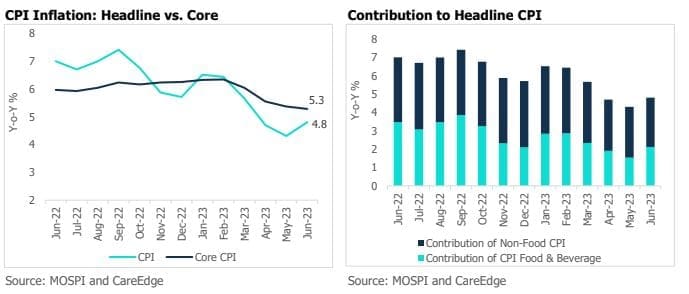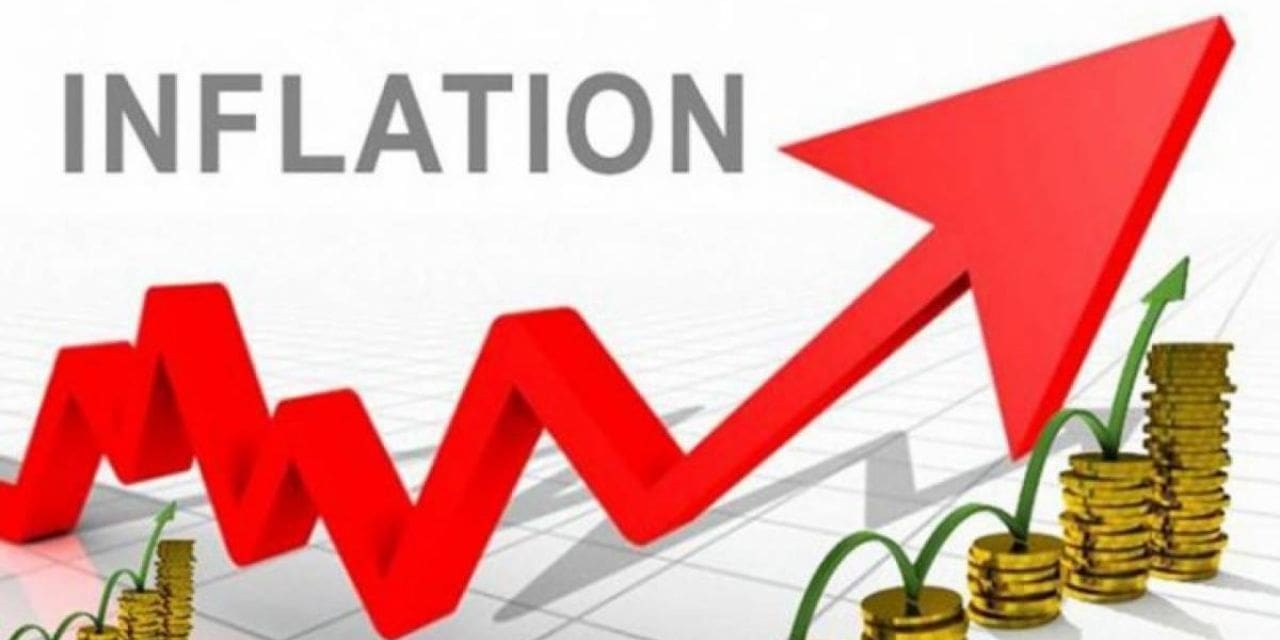India’s retail inflation snapped a four-month decline, rising 4.8% in June, but remaining within RBI’s tolerance
band. The uptick was largely driven by a sharp rise in food inflation. Food inflation rose to 4.6% from 3.3% a
month ago, taking the share of food inflation in overall inflation to 44% in June, from 36% a month ago. Amongst
food items, categories such as vegetables, pulses, spices and meat & fish registered a significant uptick. Inflation
in the miscellaneous segment, which accounts for nearly 30% of the CPI basket, also reported an increase of 5.2%
y-o-y in June from 4.9% in May.
Core inflation remained high at 5.3% y-o-y in June (vs 5.4% in May), with slight moderation in inflation in segments
such as housing, personal care & effects and recreation. However, inflation in categories such as transport and
communication, health and education firmed in June.

Food and beverage inflation spiked on account of seasonal uptick in vegetable prices and elevated pulses inflation.
Uneven monsoon and heatwave conditions are likely to have impacted essential perishable foods. Inflation in items
such as onion (8.1%), tomato (64%) and potato (10.5%) witnessed a significant uptick on a sequential basis in
June.
Cereal and pulses inflation remained elevated in June at 12.7% y-o-y and 10.5% y-o-y, respectively. Retail prices
of pulses, especially that of tur dal have risen 24% y-o-y in June, reporting double-digit growth for the third
consecutive month. On a sequential basis, wheat and rice inflation also picked pace in June. Looking ahead, the
sale of wheat and rice from the government’s buffer stock via Open Market Sale Scheme (OMSS) auctions could
help cool retail prices of rice, wheat and atta. However, with regards to rice prices, deficient monsoons in West
Bengal- a key rice-producing state, could impact sowing, putting upward pressure on prices. Overall, the total sown
area of kharif crops has declined nearly 6% as on July 9, compared to a year ago period, with that of rice and
pulses reporting declines of 16% and 18%, respectively. Despite rainfall at 2% above long period average (LPA)
as on July 11, skewed spatial distribution of rainfall could hurt crop yields and pose as a headwind to the inflation
outlook.
Although milk inflation moderated in June (8.6% y-o-y vs 8.9% in May), it continues to remain sticky above 8%,
reeling from the impact of a continued demand-supply mismatch and high fodder costs. Milk prices could remain
higher in the coming months, if unabating cereals inflation keeps cattle feed expensive.
Notably, fuel and light inflation moderated to a 30-month low of 3.9%- y-o-y in June from 4.7% in the previous
month. The softening of prices in this category was largely on account of kerosene (by PDS) segment contracting
27% y-o-y in June. Inflation in the LPG category too moderated in June, with sequential momentum reporting a
contraction for the second straight month. However, electricity, which accounts for the largest share in fuel and
light inflation, rose 8.7% y-o-y in June, from 5.2% a month prior.

Way Forward
The rise in sequential momentum of food inflation is concerning. The share of food inflation in the headline inflation
has risen to 44% from 36% in the previous month. While a part of the increase in food prices is seasonal, for some
items like vegetables, the increase is more than the seasonal pattern seen in previous years. With high inflation for
basic food items like rice, pulses, vegetables and milk, the Central Bank will be concerned about the adverse impact
on household inflationary expectations. Progress of monsoon in July would be specifically critical. If the spatial
distribution of rainfall remains skewed, it could have an adverse impact on kharif sowing and further aggravate
food inflation, going forward. Due to excessive rainfall in some regions, total sown area of items such as rice, pulses
and oilseeds is already lower than last year, which is worrisome. While food inflation is concerning, the comforting
factor is that the WPI has been contracting. Deflation in WPI will have a lagged impact on CPI inflation going
forward. Having said that, RBI would remain cautious and adopt a wait and watch mode. We reaffirm our view that
RBI would maintain an extended pause in 2023.

